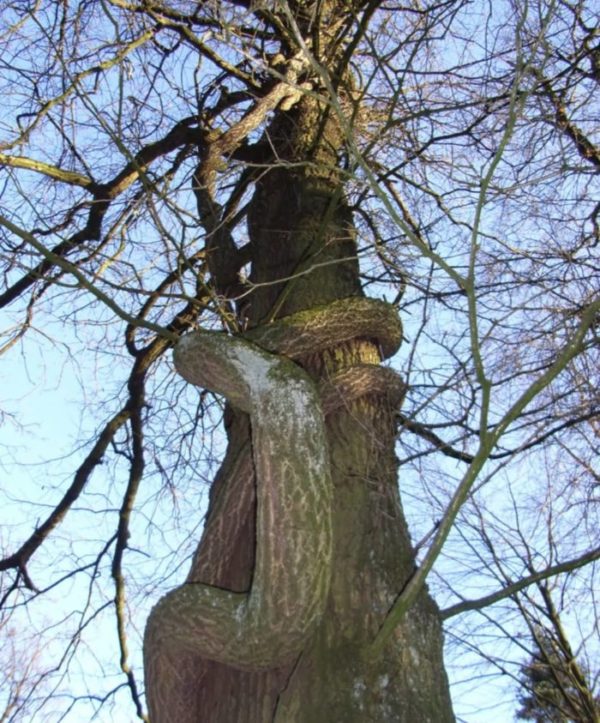A climbing vine on a mature tree can be a charming sight, particularly when its flowers are in full bloom or when a bird stops to enjoy a fall berry. The more complicated and disturbing issue is that many of the vines you see are extremely harmful to our trees.
The simplest way to differentiate the good players from the bad players may just be to watch how quickly they grow. Native vines and some ornamental species that are shade tolerant, grow on and around our trees without causing harm. We are also being confronted with a number of non-native species spreading so voraciously they are now becoming monocultures that often smother and kill trees.
You have likely noticed the mats of green covering shrubs and trees in open and disturbed areas along roadways and highways. The most dangerous culprit may be the Mile-a-minute vine, Persicaria perfoliate, an East Asian species first reported in Pennsylvania in the 1930’s found in contaminated nursery soil. It can grow 6 inches in a single day forming a dense tangled blanket of intertwined vines. It takes hold in disturbed areas where sun is able to reach the ground where it wasn’t able to before and continues to spread in contaminated soil found on machinery and along wetlands and stream beds. The situation has become so serious that UCONN is asking you to report its location using this form – https://cipwg.uconn.edu/report-mam/.
Many of these invasive vines were introduced for their larger flowers, longer blooms and berry production and can still be beautiful garden plants. The trouble starts when they break free of these bounds to compete for light, water and space with vines native to our region. Birds disseminate their seeds and, as non-natives, they have no competing species to control their growth.
Take for example American Bittersweet, Celastrus scandens vs. Oriental Bittersweet, Celastrus orbiculatus Thunb. American bittersweet is a climbing vine with an attractive autumn fruit of showy orange-red seeds which songbirds eat for fuel on cool fall days. Do not confuse this with Oriental Bittersweet, an ornamental vine introduced in 1879 that can grow 60 feet a year. The weight of mature vines can topple even the largest trees as they wind around trunks in a process known as “girdling” and eventually strangle the tree.
Another culprit is Porcelain berry, also known as Amur Peppervine, Ampelopsis glandulosa, an Asian vine in the grape family with heart shaped leaves once prized for their almost iridescent pink-purple-azure berries. It has been widely planted and is now highly invasive along forest edges and disturbed areas where birds and small mammals enjoy eating the beautiful berries, helping it spread rapidly over long distances. Our southeastern native, Heartleaf Peppervine, Ampelopsis cordata, now found in Connecticut, will not dominate and also features heart shaped leaves with smaller showy white berries that birds like to eat.
And then there are the Ivy’s… and this is not about education. A native you may be all too familiar with and would prefer not to be is Poison Ivy, Toxicodendron radicans. While it readily climbs trees, it rarely causes damage. While birds and other wildlife feast on its berries, it is best left in areas far from patios and paths to avoid unpleasant, and sometimes dangerous, skin irritations. How does something as sweet sounding as English Ivy do so much damage? English Ivy grows along the forest floor as well as up trees and crowds out most all other species. It can be a useful garden ground cover but it knows no boundaries and is an extremely problematic vine now readily seen in wooded areas. CT has recorded a 90-foot-long vine with a 1-foot diameter!
Two others to be on the lookout for are Autumn Clematis, Clematis terniflora, an ornamental introduced in the 1890’s and Kudzu vine, Pueraria montana, the vine that ate the south and now seen in Greenwich.
The stunner of all climbing vine blossoms might be the Wisteria. Connecticut has a native species, American Wisteria, Wisteria frutescens, which does not grow as aggressively as the Japanese, Wisteria floribunda, that twines counterclockwise and Chinese Wisteria, Wisteria sinensis, which twines clockwise. Both have been favored in garden centers for many decades. You can most easily distinguish them by when they bloom as our native Wisteria blooms June – August and the non-natives March -May.
Our trees need us to be more attentive than ever before. We quite naturally see them as part of the green backdrop of our lives. Take a moment to look a bit closer and steward them more thoughtfully so that you can enjoy the many benefits they provide for years to come. Vine identification and removal when necessary is a valuable component of tree care. When you see trees becoming covered in vines; take action. You can make a quick identification using a leaf ID app or speak with your tree care professional.
The Greenwich Tree Conservancy, in partnership with the town of Greenwich, removes vines where possible to protect the health of our town tree canopy and encourages you to care for the trees on your property and in your neighborhood. If we can be of any assistance please reach out at greenwichtreeconservancy@gmail.com



